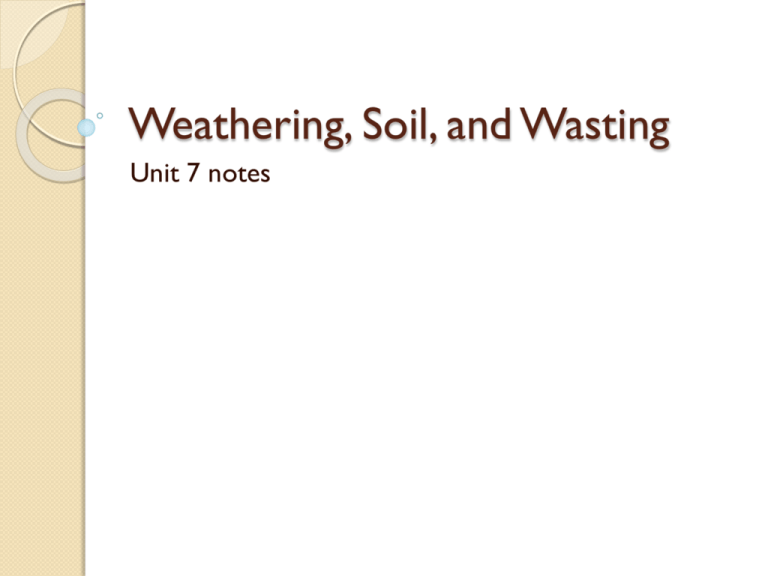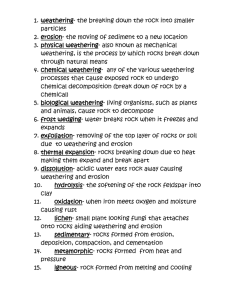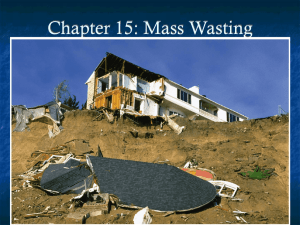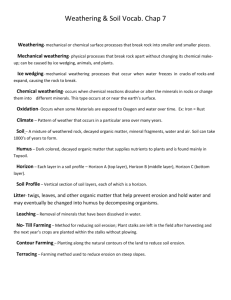(parent) material
advertisement

Weathering, Soil, and Wasting Unit 7 notes Weathering What is it? ◦ Disintegration and Decomposition of rocks Where does it happen? ◦ At or near the surface of the Earth Weathering What does this process look like? Weathering Why does it happen? ◦ It is the response of Earth’s materials to the changing environment. Weathering How many types are there? ◦ Mechanical ◦ Chemical Weathering- Mechanical A physical process Rocks are broken into smaller and smaller pieces, each retaining the characteristics of the original (parent) material Weathering- Mechanical Frost Wedging ◦ Water enters and fills cracks in the rock. It will expand when the water freezes and push the rock apart more. Weathering- Mechanical Talus Slopes ◦ The pile of rocks that forms at the base of a vertical rock formation. Most often the result of frost wedging. Weathering- Mechanical Unloading ◦ Large scale loss of rocks off of the original parent material Weathering- Mechanical Sheeting is also known as exfoliation. ◦ What is exfoliation on people? Weathering- Mechanical Sheeting◦ When large masses of rock (particularly igneous) are exposed and large flat pieces are broken off due to a reduction in pressure Weathering- Mechanical Thermal Expansion ◦ What happens when you heat something up? ◦ Cool something down? Weathering- Mechanical Biological activity ◦ Plants, animals (including humans), lichens, mosses ◦ Plant roots will wedge in between rocks to seek water. Lichens will actually digest the surface of rocks for nutrients. And humans will do what we do… Weathering- Chemical Carbonic Acid◦ H2CO3 is produced when CO2 dissolves in H2O. ◦ Water vapor in the air undergoes this reaction. Weathering- Chemical How carbonic acid works on Feldspar… ◦ 2 KAlSi3O8 + 2 H2CO3 + H20 Al2Si2O5(OH)4 + 2KHCO3 + 4SiO2 ◦ What it looks like… Weathering- Chemical Rocks that undergo this process tend to take on a spherical shape. Soil “Science, in recent years , has focused more and more on the Earth as a planet, one that for all we know is unique-where a thin blanket of air, a thinner film of water and the thinnest veneer of soil combine to support a web of life of wondrous diversity in continuous change.” ◦ Jack Eddy 1993 Soil Regolith ◦ The surface layer of the Earth that is composed only of weathered rock and mineral fragments Soil What is it? ◦ A combination of weathered mineral particles, organic matter, water, and air What makes for good soil? ◦ A mixture of approximately 50% regolith and 50% humus (decayed organic material) Soil This is where erosion fits into the mix. Soil As materials are eroded, certain minerals and elements can be left behind or concentrated to form ore and mineral deposits. Mass Wasting Large movements of rock and/or soil in a downhill direction Mass Wasting Triggers of mass wasting ◦ Water saturation Mass Wasting Triggers of mass wasting ◦ Oversteepened slopes Mass Wasting Triggers of mass wasting ◦ Vegetation- or rather removal of vegetation Mass Wasting Triggers of mass wasting ◦ Earthquakes




